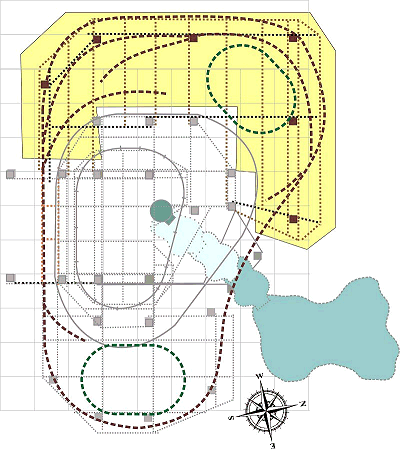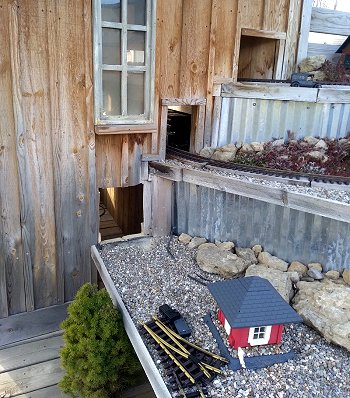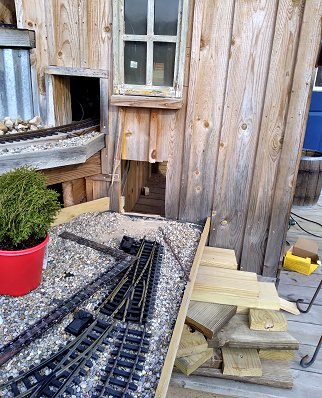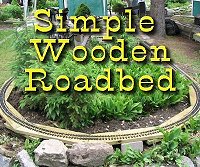 | |||
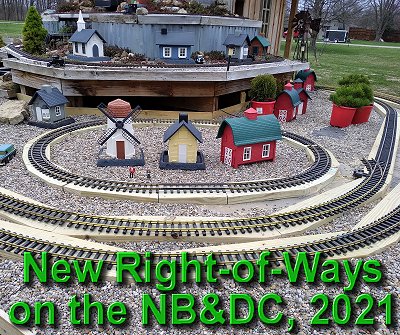 |
 |  | |
 |  | ||
 |  | ||
 |  | ||
 |  | ||

| Please Read: How to Help Our Site at No Cost to You - Some of our articles contain recommendations for products we like and vendors we personally trust. Some of those vendors may pay us a very small commission if you click on a link and buy their products. This costs you nothing at all and helps offset the costs of what we do. So if we point you to something you decide to buy later, please make certain you come back through our site and click on the link directly. Thanks. |


|
New Right-of-Ways on the New Boston & Donnels Creek RR, 2021This is a follow-up to our article My plan from the start was to have a single big loop connecting the two platforms, "bridging" the waterfall like the higher loops. But that wasn't going to happen late last fall. Instead, I set out two temporary loops on the new platform.
The drawing below right shows my plan for the big loop once the ROW went through the shed and across the waterfall. Initially, it looked a bit different, but I took a bunch of odds and ends track outside and kept fastening them together to get the optimum plan. The new Right-of-Way would use only 10'-diameter or larger curves, so I could run longer equipment. Also, I wanted a passing track that would store a fairly long train - as it turns out the passing track you see at the top of the page will hold a train about 18 feet long. (I had a similar "passing track" on my old railroad that I wound up never using because the turnouts were out of reach and in the habit of not throwing all the way, even with the best switch mechanisms).
HolesThe track would have to go through the shed, which means two more holes in the shed. From the outside I drilled holes so I would know where to cut. Then I took a reciprocating saw to the inside for a few minutes of vibrating like a cartoon character who has been hit by a mallet.
I had four 5'-pieces of AristoCraft track that were left over from a series of clinics I did in 2008, at Holden Arboretum, near Cleveland Ohio. Plus a circle of 10'-diameter track in pretty good shape, and a bunch of other odds and ends. That included the 4'- and 5'-diameter curved pieces from the temporary loops I put up last November.
|
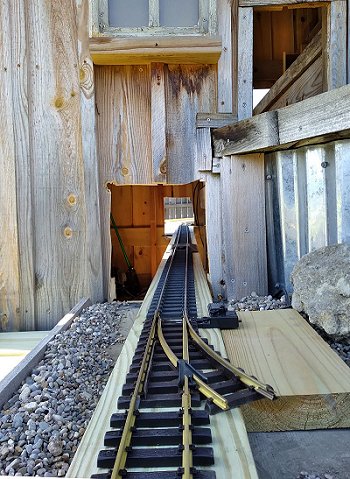 |
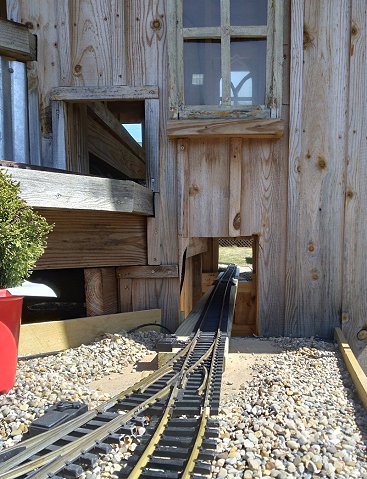 |
Why did I fasten that board down first? Because its location is the least "negotiable" of all the roadbed pieces. All the other track placement depends on exactly where the track comes out of the train shed.
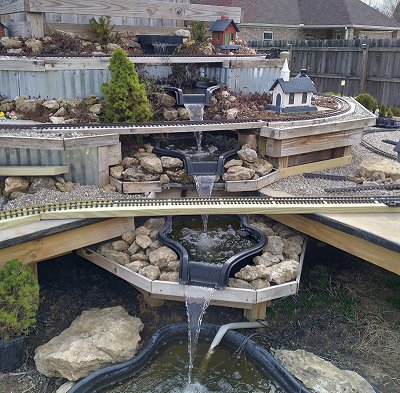 Afterwards, I set out the rest of the roadbed for the east side of the platform, and cut a piece for where I figured the bridge would need to be. To stretch that board across, I had to remove the trim pieces that were holding back the gravel along the edges.
Afterwards, I set out the rest of the roadbed for the east side of the platform, and cut a piece for where I figured the bridge would need to be. To stretch that board across, I had to remove the trim pieces that were holding back the gravel along the edges.
I didn't fasten the new "bridge" down until I'd put roadbed under all the 10' curves on the west platform (to the right in this photo). Again, I wanted to make certain of exactly where the track was going to go before I did anything permanent.
In the interest of full disclosure, the pieces did not all align quite as I thought they should until I replaced a 2' piece of track near the bridge with a non-functioning wide-radius turnout (the straight edge along the mainline, of course). It was a bit shorter, and gave the track plan the "give" it needed to fit where I wanted it to go. So one of the sidings in my drawing above now goes in the opposite direction from the way I had it drawn, and it won't actually function until I replace or fix the turnout. Yes, I could have just sawn a piece of track a bit shorter, but then I would have had to use third-party track joiners, and I'm not a fan of most of them. Don't tell my friends who are sticklers for operations about the non-working turnout.
Then I recut and restored the trim pieces I had had to move, so I could spread the gravel back on those corners.
 After I cut and installed the roadbed for the rest of the mainline, I set my circular saw for about 1 5/8" and trimmed the corners a little. Due to slightly uneven depths of the boards, this gouged the decking in a few places and failed to cut quite all the way through in others.
After I cut and installed the roadbed for the rest of the mainline, I set my circular saw for about 1 5/8" and trimmed the corners a little. Due to slightly uneven depths of the boards, this gouged the decking in a few places and failed to cut quite all the way through in others.
Neither was really a problem - the decking is ground-rated after all, and the bits that weren't cut all the way through were easily pulled off.
Then I cut and installed the roadbed for the two inner loops that remain. The photo to the right shows the east platform after the roadbed was installed and the gravel was replaced.
I haven't installed the sidings yet, because I wouldn't exactly be doing operations for the Easter Egg hunters who would be visiting in a few days. I also spread the gravel back out to give the platforms a more finished look than exposed black tarp.
The buildings you see are still North States bird feeders I put out during the winter to keep the railroad from looking naked. Most of them are weighed down with gravel in the part that is supposed to hold bird feed. The ones that aren't occasionally blow away, especially in windy Spring storms - another reason to keep the "good buildings" inside until warmer weather.
The photo to the left below shows the inner loop on the west platform after the roadbed has been screwed into place. This loop has two 1' straights, four 5'-diameter curves, and eight 4'-diameter curves. The 5' curve pieces are attached to the straight pieces and act (somewhat) as "easements" into the smaller curves. To cut the roadbed, I had to cut two different lengths of "trapezoids."
The photo to the right below shows the same area after the roadbed for the inner loop has been finished and the corners trimmed.
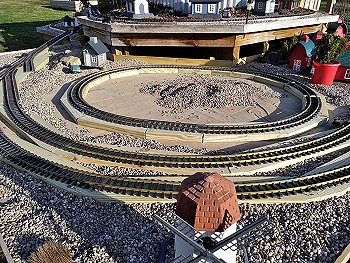 |
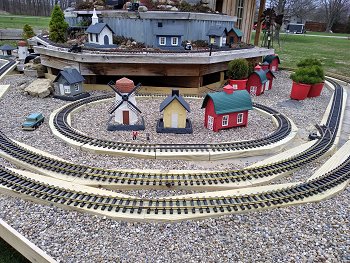 |
Getting Ready for Visitors
Soon after getting the new platforms to the point shown in the above photos, we had a number of visitors who came over from the neighbor's Easter egg hunt. Because we knew they were coming, I set out my Lionel G-gauge Thomas and James and my Bachmann Percy. All started out pulling trains, but Percy ditched his "Li'l Big Hauler" coaches early on - turns out the spring on his rear coupler had failed. Later on, Thomas ditched Annie and Clarabel - the couplers on those coaches are falling apart, too. James kept the "Troublesome Trucks" going just fine for the whole day, but in the interest of full disclosure, that train was "new old stock." All of the couplers were LGB-style hook-and-latch couplers, which are ordinarily very reliable if they are intact. This tells me I'll be needing to do some coupler inspection/repair/replacement before I get the trio out again for our Christmas-themed open railroad this fall.Rounding out the train appearances were an LGB Porter hauling three HLW mini-gondolas and a silver Eggliner. (You HAVE to run an Eggliner for Easter visitors, don't you?)
There were many delighted visitors, who are not shown on this page because I was too busy to take photos. All the children were very well behaved, and all of the parents and grandparents who brought them over were very responsible.
Five running trains and a four-level waterfall captured the interest of the adults as well as the kids. And, unlike our scheduled open railroads, we didn't have to provide snacks, as the Easter egg hunt across the street covered that base.
Future Efforts
I had originally planned for the lower platform to be half again as big as it is, but I couldn't find useful lumber for most of 2020, and what I did find cost way more than it did in 2019. That said, if all I do from this point is to install dirt, rocks, groundcovers, trees, buildings, lighting, and accessories on the railroad I've built so far, that will take at least the rest of the season to do properly.Next step, though, is cleaning out the pond. That includes gradually flushing the old water out, cleaning the filter, netting out leaves that settled on the bottom during the winter, raising the "shallow-water" plants to their shelves, and treating the new water against algae bloom (which used to happen in June and now is happening in March - go figure). The water lily is already sending up leaves, so spring is on its way.
Keep in Touch
A decade ago, at our old house, a friend from the east coast used to visit his parents each Easter, and he would often ask if he could stop by and see the railroad running. Sadly, I never had the railroad ready for viewers until about Memorial Day; the maintenance required to recover from winter ground shifts, weed creep, etc. was too great. So, being able to run trains for visitors before Easter this year is especially rewarding. In fact, with our current infrastructure, there's no reason we couldn't run trains any day of the year that that the weather permits.
If you're headed toward or past Springfield, Ohio, please let me know, and I'll see if we can work out a quick visit.
Finally, please let us know about your ongoing projects. Ask questions, send corrections, suggest article ideas, send photos, whatever you think will help you or your fellow railroaders. In the meantime, enjoy your trains, and especially enjoy any time you have with your family in the coming weeks,
Paul Race
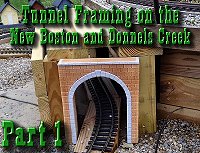 Proceed to "Tunnel Framing on the New Boston and Donnels Creek, Part 1." We planned and built two wooden boxes that would become the framework for two short tunnels on our raised platform railroad. That effort was made a little more complicated by the fact it was a "retrofit." I hadn't planned for them at first, so getting them in place took some finangling.
Proceed to "Tunnel Framing on the New Boston and Donnels Creek, Part 1." We planned and built two wooden boxes that would become the framework for two short tunnels on our raised platform railroad. That effort was made a little more complicated by the fact it was a "retrofit." I hadn't planned for them at first, so getting them in place took some finangling.
Click on the picture to see our status as of mid-July, 2021.
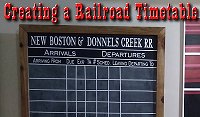 Return to "Creating a Railroad Timetable" - No train station would be complete without a timetable showing arrivals and departures (as well as expected arrivals and departures). We made one with a big piece of underlayment, framed it with scrap lumber, cut lettering for it with a craftcutter, and lined it with striping tape. This one is hinged to a shallow shelving unit that is holding the dvds we sometimes watch while working on projects in our workshop.
Return to "Creating a Railroad Timetable" - No train station would be complete without a timetable showing arrivals and departures (as well as expected arrivals and departures). We made one with a big piece of underlayment, framed it with scrap lumber, cut lettering for it with a craftcutter, and lined it with striping tape. This one is hinged to a shallow shelving unit that is holding the dvds we sometimes watch while working on projects in our workshop.
Click on the picture to see our status as of January, 2021.
 Return to "Christmas Preparations and Operations 2020" - A series of families were going to visit during the holiday season (masked and distanced, of course), so we just had to do a little Christmas decorating, and get as many trains running as possible for the kids. This included laying temporary ROWs on the new platform and setting up two Lionel RTP trains for kids to run.
Return to "Christmas Preparations and Operations 2020" - A series of families were going to visit during the holiday season (masked and distanced, of course), so we just had to do a little Christmas decorating, and get as many trains running as possible for the kids. This included laying temporary ROWs on the new platform and setting up two Lionel RTP trains for kids to run.
 Return to "Garage to Train Station, Part 2" - continuing to fix up one end of my garage to resemble a Victorian train station interior. I used a digital projector to outline vintage coach details for my windowframes. Then I painted the backgrounds, attached the windowframes, and installed them on the wall. A repro Regulator clock and other details are added.
Return to "Garage to Train Station, Part 2" - continuing to fix up one end of my garage to resemble a Victorian train station interior. I used a digital projector to outline vintage coach details for my windowframes. Then I painted the backgrounds, attached the windowframes, and installed them on the wall. A repro Regulator clock and other details are added.
Click on the picture to see our status as of late December, 2020.
 Return to "Garage to Train Station, Part 1" - fixing up one end of my garage to resemble a Victorian train station interior. The initial steps included demolition, patching the ceiling and walls, moving electrical outlets, adding wainscotting and baseboard, and planning for windowframes with painted backgrounds.
Return to "Garage to Train Station, Part 1" - fixing up one end of my garage to resemble a Victorian train station interior. The initial steps included demolition, patching the ceiling and walls, moving electrical outlets, adding wainscotting and baseboard, and planning for windowframes with painted backgrounds.
Click on the picture to see our status as of early December, 2020.
 Return to "Westward Expansion, 2020, Part 3" - Thanks to a spate of unusually warm weather in early November, I was able to get the new platform finished, lined with vinyl, and bordered with trim boards to keep the dirt and gravel in place.
Return to "Westward Expansion, 2020, Part 3" - Thanks to a spate of unusually warm weather in early November, I was able to get the new platform finished, lined with vinyl, and bordered with trim boards to keep the dirt and gravel in place.
The next "permanent" improvements will wait for now. In the meantime, we will set out buildings and a temporary loop or to entertain visitors between now and Christmas.
Click on the picture to see our status as of mid-November, 2020.
 Return to "Westward Expansion, 2020, Part 2" - We had to be careful leveling the last joists so the frame, decking, and right-of-way would be as level as possible. Fortunately we were able to get enough lumber to get a good start on the frame.
Return to "Westward Expansion, 2020, Part 2" - We had to be careful leveling the last joists so the frame, decking, and right-of-way would be as level as possible. Fortunately we were able to get enough lumber to get a good start on the frame.
We also added one last tweak to the frame design to make it easier to extend this platform to its originally planned size, if and when we get a chance to do so.
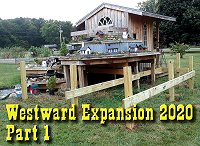 Return to "Westward Expansion, 2020, Part 1" - With a lumber shortage and warm weather running out, we revised our plans for the next addition, bought what decent lumber we could find, dug holes, installed posts, and attached joists.
Return to "Westward Expansion, 2020, Part 1" - With a lumber shortage and warm weather running out, we revised our plans for the next addition, bought what decent lumber we could find, dug holes, installed posts, and attached joists.
We were hoping to get the lumber we need to finish the platform before cold weather set in. Click on the link to see our status as of late September, 2020.
 Return to "Train Storage Solutions, 2020" - Using periods of cold weather to get things sorted in the garage, including shelf building and tips for schlepping trains from storage to the tracks.
Return to "Train Storage Solutions, 2020" - Using periods of cold weather to get things sorted in the garage, including shelf building and tips for schlepping trains from storage to the tracks.
Click on the following link to see our status as of late January, 2020. https://familygardentrains.com/newbost/20_1_19_shelves/shelves.htm
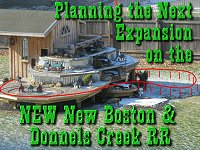 Return to "Expansion Planning, 2020" - Three years after starting a garden railroad in our new home, we are trying to figure out the best way to finish the last loop of our raised platform railroad. How to make room for 10'-diameter curves and more towns and industries, but still keeping things manageable requires some thinking and rethinking.
Return to "Expansion Planning, 2020" - Three years after starting a garden railroad in our new home, we are trying to figure out the best way to finish the last loop of our raised platform railroad. How to make room for 10'-diameter curves and more towns and industries, but still keeping things manageable requires some thinking and rethinking.
Click on the photo to see the options we were reviewing for the next and last expansion.
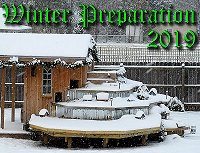 Return to "Winter Preparation, 2019" - After the big open railroad event, we try to prepare the railroad for the cold months, including populating the railroad with North States bird feeders so it doesn't look empty, adding an air pump and bubblers to the pond, and more.
Return to "Winter Preparation, 2019" - After the big open railroad event, we try to prepare the railroad for the cold months, including populating the railroad with North States bird feeders so it doesn't look empty, adding an air pump and bubblers to the pond, and more.
Click on the following link to see our status as of early December, 2019. https://familygardentrains.com/newbost/19_11_24_winter_prep/19_11_24_winter_prep.htm
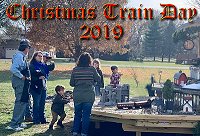 Return to "Christmas Train Day, 2019" - Three years after starting a garden railroad in our new home, we host another Christmas-themed open railroad, giving many families a jump start on Christmas celebrations and sharing the experience of running trains with lots of kids.
Return to "Christmas Train Day, 2019" - Three years after starting a garden railroad in our new home, we host another Christmas-themed open railroad, giving many families a jump start on Christmas celebrations and sharing the experience of running trains with lots of kids.
Click on the photo to see a brief record of our busiest weekend in November, 2019.
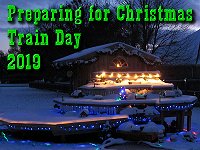 Return to "Preparing for Christmas Train Day 2019" - Wrapping up construction projects for 2019 and getting ready for our annual Christmas-themed open railroad. Includes new lighting and other features, providing a temporary home for a Hogwarts Express train, weather issues, and more. Click to go to article.
Return to "Preparing for Christmas Train Day 2019" - Wrapping up construction projects for 2019 and getting ready for our annual Christmas-themed open railroad. Includes new lighting and other features, providing a temporary home for a Hogwarts Express train, weather issues, and more. Click to go to article.
Click on the following link to see our progress of mid-November, 2019.
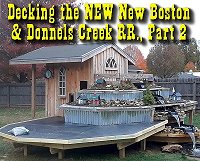 Return to Decking the NEW New Boston and Donnels Creek Part 2 - Getting the next part of the railroad ready to install trains. Includes installing 2"x6" decking, vinyl sheeting, edges to hold back the gravel, and corrugated steel panels. It's not done, but it will give us another place to set up trains for our next Christmas-themed open railroad.
Return to Decking the NEW New Boston and Donnels Creek Part 2 - Getting the next part of the railroad ready to install trains. Includes installing 2"x6" decking, vinyl sheeting, edges to hold back the gravel, and corrugated steel panels. It's not done, but it will give us another place to set up trains for our next Christmas-themed open railroad.
Click on the photo to see our status as of late October, 2019.
 Return to "Framing the NEW New Boston and Donnels Creek RR - Part 7" - Installing posts, joists, framing, and decking for the eastern expansion of the NEW New Boston and Donnels Creek. Although this installation was complicated by having to fit into an existing framework, the methods used could work for any raised-platform railroad.
Return to "Framing the NEW New Boston and Donnels Creek RR - Part 7" - Installing posts, joists, framing, and decking for the eastern expansion of the NEW New Boston and Donnels Creek. Although this installation was complicated by having to fit into an existing framework, the methods used could work for any raised-platform railroad.
Click on the following link to see our progress of early October, 2019.
 Return to "Planning the NEW New Boston and Donnels Creek RR - Part 5" - Once the major components of the water feature were installed and tested, we decided to add one more bit of railroad proper before our "Christmas Train Day," this November. The addition, about 5'x11', will allow us to put a small train and some scenery closer to eye level for youngsters. Eventually it will be part of the larger plan that will allow us to run our bigger cars and locomotives.
Return to "Planning the NEW New Boston and Donnels Creek RR - Part 5" - Once the major components of the water feature were installed and tested, we decided to add one more bit of railroad proper before our "Christmas Train Day," this November. The addition, about 5'x11', will allow us to put a small train and some scenery closer to eye level for youngsters. Eventually it will be part of the larger plan that will allow us to run our bigger cars and locomotives.
Click on the photo to see our plans for the next addition, as of late September, 2019.
 Return to Waterscaping Part 4. - Installing the last connecting pool, so the whole planned waterfall is complete except for dirtscaping and planting.
Return to Waterscaping Part 4. - Installing the last connecting pool, so the whole planned waterfall is complete except for dirtscaping and planting.
The process included checking the pump, extending the hoses, rescuing toads, building the platform, trimming the platform, testing the pool's location, etc.
Click the photo to go to the article.
 Return to "Waterscaping, Part 3" - After seven months of crazy long work hours, I finally got some free time to continue working on the railroad. Weather permitting, I often worked all the live-long day. This article describes installing two posts that will eventually support the last connecting pool, then digging the big hole for the in-ground pond, complicated by a three-month drought that turned the ground to concrete.
Return to "Waterscaping, Part 3" - After seven months of crazy long work hours, I finally got some free time to continue working on the railroad. Weather permitting, I often worked all the live-long day. This article describes installing two posts that will eventually support the last connecting pool, then digging the big hole for the in-ground pond, complicated by a three-month drought that turned the ground to concrete.
Click on the photo to see our progress as of mid-September, 2019.
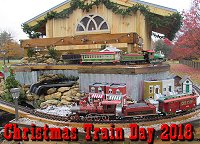 Return to Christmas Train Day, 2018 - After two years without our traditional Christmas Train Day (something we did from 2008 through 2015), we were anxious to get started again, even without a huge right of way to show off. The kids' trains, the extra Thomas railroad, the popcorn popper and two Bachmann Christmas trains got a big workout. And the visiting kids all loved it!
Return to Christmas Train Day, 2018 - After two years without our traditional Christmas Train Day (something we did from 2008 through 2015), we were anxious to get started again, even without a huge right of way to show off. The kids' trains, the extra Thomas railroad, the popcorn popper and two Bachmann Christmas trains got a big workout. And the visiting kids all loved it!
Click on the photo to see a lot of last-minute preparations and some photos of the November 10, 2018 event itself.
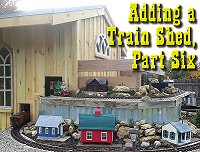 Return to "Adding a Train Shed Part 6" - Installing the board and batten siding on our train shed, installing the windows, installing the trim, testing the "tunnel entrances," and more.
Return to "Adding a Train Shed Part 6" - Installing the board and batten siding on our train shed, installing the windows, installing the trim, testing the "tunnel entrances," and more.
By the way, going over lumber receipts in early 2019, I couldn't believe I was still siding the train shed in late October, and managed to have an open railroad in mid-November. It is a little crazy how fast things can go together if you have a deadline and a lot of gift cards.
Click on the photo to see our progress as of late October, 2018.
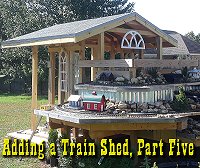 Return to "Adding a Train Shed Part 5" - Planning the doors, walls, and windows of our garden train shed.
Return to "Adding a Train Shed Part 5" - Planning the doors, walls, and windows of our garden train shed.
Includes choosing the siding and windows, installing the door, painting the windowframes, and adding crosspieces to support the vertical siding boards.
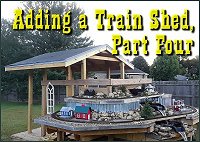 Return to "Adding a Train Shed Part 4" - Choosing and installing underlayment and drip edge to protect the sheathing until I can get the final roof installed.
Return to "Adding a Train Shed Part 4" - Choosing and installing underlayment and drip edge to protect the sheathing until I can get the final roof installed.
Now the roof is waterproof enough to get us through the next couple of months at least, maybe more.
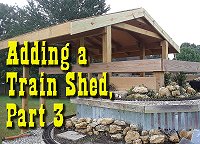 Return to "Adding a Train Shed Part 3" - Adding fascia, sheathing, and end trim to the in-progress train shed.
Return to "Adding a Train Shed Part 3" - Adding fascia, sheathing, and end trim to the in-progress train shed.
I thought about bringing in helpers for this part, but a reader commented on how helpful it was to see how one person could do this sort of thing by himself, so I just kept plugging away.
Click on the photo to see our progress as of September 13, 2018
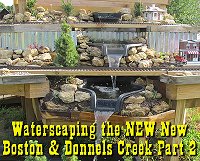 Return to "Waterscaping Part 2" - Getting this year's waterscaping project done (for now at least). Installing and dirtscaping the third level of the waterfall. Installing pump and filter, adding an extra container and modifying the ones we already had installed to keep the water running smoothly. And lots of other tweaking. Includes tips about introducing fish and plants, as well as other information about water features in general that you may find helpful.
Return to "Waterscaping Part 2" - Getting this year's waterscaping project done (for now at least). Installing and dirtscaping the third level of the waterfall. Installing pump and filter, adding an extra container and modifying the ones we already had installed to keep the water running smoothly. And lots of other tweaking. Includes tips about introducing fish and plants, as well as other information about water features in general that you may find helpful.
Click on the photo to see our status as of August 5, 2018.
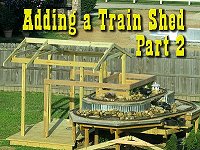 Return to "Adding a Train Shed Part 2" - Adding rafters to the frame of the in-progress train shed. Now it's starting to look like it might actually be a structure and not just a crazy collection of posts.
Return to "Adding a Train Shed Part 2" - Adding rafters to the frame of the in-progress train shed. Now it's starting to look like it might actually be a structure and not just a crazy collection of posts.
The way we got the rafters and ridge board up wouldn't work for everybody, but it worked for us, and hopefully will help other folks to "think outside the box" - literally in this case.
Click on the photo to see our progress as of July 14, 2018.
 Return to "Adding a Train Shed Part 1" - What started out as a simple addition of a deck to stand on when putting trains on the track got a little more ambitious when I realized that JUST installing the deck this year would require more work next year. So we framed out what we planned to be a train shed attached to the railroad. If it ever gets finished, I can easily put trains on the track at a moment's notice instead of schlepping them out from the garage.
Return to "Adding a Train Shed Part 1" - What started out as a simple addition of a deck to stand on when putting trains on the track got a little more ambitious when I realized that JUST installing the deck this year would require more work next year. So we framed out what we planned to be a train shed attached to the railroad. If it ever gets finished, I can easily put trains on the track at a moment's notice instead of schlepping them out from the garage.
Click on the photo to see our status as of July 9, 2018.
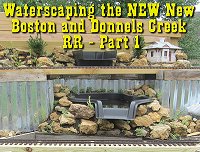 Return to "Waterscaping the NEW New Boston and Donnels Creek Part 1," our article on getting the top two layers of the waterfall on solid footing and getting the third layer framed. After we finish decking and dirtscaping the third layer, we will probably add a washbasin or something for the water to flow into, then add a pump to get the waterfall flowing. No big pond until next year at least - too many other projects.
Return to "Waterscaping the NEW New Boston and Donnels Creek Part 1," our article on getting the top two layers of the waterfall on solid footing and getting the third layer framed. After we finish decking and dirtscaping the third layer, we will probably add a washbasin or something for the water to flow into, then add a pump to get the waterfall flowing. No big pond until next year at least - too many other projects.
Click on the photo to see our progress as of June 13, 2018.
 Return to "Dirtscaping the NEW New Boston and Donnels Creek RR, Part 2. - Adding barriers to keep the rocks, dirt, and plants where they're supposed to go, placing platforms and running wiring for buildings, adding rocks, dirt, and plants to the upper level of the railroad.
Return to "Dirtscaping the NEW New Boston and Donnels Creek RR, Part 2. - Adding barriers to keep the rocks, dirt, and plants where they're supposed to go, placing platforms and running wiring for buildings, adding rocks, dirt, and plants to the upper level of the railroad.
Click on the photo to see our status as of June 1, 2018.
 Return to "Adding Raised Roadbed to the NEW New Boston and Donnels Creek, Part 2" - Trimming the corners off the roadbed on the upper layer and cutting the pieces that will support the curves on the middle layer. We need to get the upper two tiers of the pond installed before we totally complete this step, so the article doesn't quite show the finished product. You'll see it later as part of other articles.
Return to "Adding Raised Roadbed to the NEW New Boston and Donnels Creek, Part 2" - Trimming the corners off the roadbed on the upper layer and cutting the pieces that will support the curves on the middle layer. We need to get the upper two tiers of the pond installed before we totally complete this step, so the article doesn't quite show the finished product. You'll see it later as part of other articles.
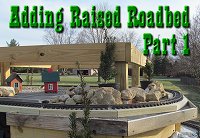 Return to "Adding Raised Roadbed to the NEW New Boston and Donnels Creek RR, Part 1" - Sorting out our priorities for the spring and summer of 2018. There a lot of little chores we really should get done before we start on the next big addition. Click to see our plans as of February 27, 2018.
Return to "Adding Raised Roadbed to the NEW New Boston and Donnels Creek RR, Part 1" - Sorting out our priorities for the spring and summer of 2018. There a lot of little chores we really should get done before we start on the next big addition. Click to see our plans as of February 27, 2018.
Click on the photo to see our status as of February 20, 2018
 Return to "2018: Springing into Spring on the NEW New Boston & Donnels Creek RR." - Sorting out our priorities for the spring and summer of 2018. There a lot of little chores we really should get done before we start on the next big addition. Click to see our plans as of February 27, 2018.
Return to "2018: Springing into Spring on the NEW New Boston & Donnels Creek RR." - Sorting out our priorities for the spring and summer of 2018. There a lot of little chores we really should get done before we start on the next big addition. Click to see our plans as of February 27, 2018.
Click on the photo to see our status as of February 20, 2018
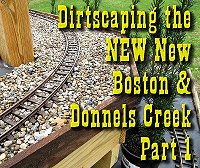 Return to "Dirtscaping the NEW New Boston and Donnels Creek RR, Part 1. - Putting edging around the existing "layers" of the new railroad, and beginning to add gravel and rocks. There were a few test runs, but we got stopped early by bad weather before we could dump the rest of the rocks, gravel, and dirt, much less plant the plants we hoped to get in before snowfall.
Return to "Dirtscaping the NEW New Boston and Donnels Creek RR, Part 1. - Putting edging around the existing "layers" of the new railroad, and beginning to add gravel and rocks. There were a few test runs, but we got stopped early by bad weather before we could dump the rest of the rocks, gravel, and dirt, much less plant the plants we hoped to get in before snowfall.
Click on the photo to see our status as of November 21, 2017
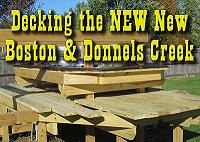 Return to "Decking the NEW New Boston and Donnels Creek RR - Decking the 'middle layer' of our proposed three-tier outdoor railroad. Prepping more track, laying out track and decking to make certain we have measurements correct, installing most of the remaining decking for this layer.
Return to "Decking the NEW New Boston and Donnels Creek RR - Decking the 'middle layer' of our proposed three-tier outdoor railroad. Prepping more track, laying out track and decking to make certain we have measurements correct, installing most of the remaining decking for this layer.
Click on the photo to see our status as of October 25, 2017
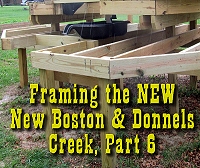 Return to "Framing the NEW New Boston and Donnels Creek RR, Part 6" - Modifying and finishing the framing on the second layer, cantilevering, using R3 track versus all other pre-curved track formats, finalizing the track plan, why painting the track makes old and new track blend better, and more. This will be the last bit of "framing" in 2017, and it worked out well, considering.
Return to "Framing the NEW New Boston and Donnels Creek RR, Part 6" - Modifying and finishing the framing on the second layer, cantilevering, using R3 track versus all other pre-curved track formats, finalizing the track plan, why painting the track makes old and new track blend better, and more. This will be the last bit of "framing" in 2017, and it worked out well, considering.
Click on the photo to see our status as of October 15, 2017
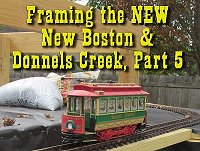 Return to "Framing the NEW New Boston and Donnels Creek RR, Part 5" - Spreading the billboard-sourced vinyl underlayment on the top layer. Prepping used Aristo track for (hopefully) many more years of service. Laying the first loop of track, attaching power wires with spade terminals, and testing conductivity with a Bachmann streetcar.
Return to "Framing the NEW New Boston and Donnels Creek RR, Part 5" - Spreading the billboard-sourced vinyl underlayment on the top layer. Prepping used Aristo track for (hopefully) many more years of service. Laying the first loop of track, attaching power wires with spade terminals, and testing conductivity with a Bachmann streetcar.
Click on the photo to see our status as of October, 10, 2017
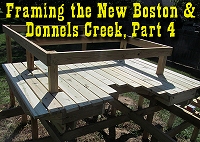 Return to "Framing the NEW New Boston and Donnels Creek RR, Part 4" - Planning and running the decking for the top layer, testing the track plan, checking clearances, prepping used track with new railjoiners, examining the vinyl I ordered to go over the decking, and more.
Return to "Framing the NEW New Boston and Donnels Creek RR, Part 4" - Planning and running the decking for the top layer, testing the track plan, checking clearances, prepping used track with new railjoiners, examining the vinyl I ordered to go over the decking, and more.
Click on the photo to see our status as of September 26, 2017
 Return to "Framing the NEW New Boston and Donnels Creek RR, Part 3" -
Getting the frame finished on the top layer, ordering other things I'd need eventually, deciding on materials for the decking on the top layer (at least).
Return to "Framing the NEW New Boston and Donnels Creek RR, Part 3" -
Getting the frame finished on the top layer, ordering other things I'd need eventually, deciding on materials for the decking on the top layer (at least).
Click on the photo to see our status as of September 17, 2017
 Return to "Framing the NEW New Boston and Donnels Creek RR, Part 2" -
Once I had the overall frame relatively solid, I hooked up the underground power lines to two GFI plugs that should be in easy reach once everything is finished. I also decided to frame out the top railroad layer while I could still access the center of the railroad easily. Because I was running out of vertical space, I reconfigured that layer. Then after I got the "core" pieces on, I changed my plan again. But the whole thing is getting easier and easier to visualize, and is getting closer to complete with every board I cut and fasten on.
Return to "Framing the NEW New Boston and Donnels Creek RR, Part 2" -
Once I had the overall frame relatively solid, I hooked up the underground power lines to two GFI plugs that should be in easy reach once everything is finished. I also decided to frame out the top railroad layer while I could still access the center of the railroad easily. Because I was running out of vertical space, I reconfigured that layer. Then after I got the "core" pieces on, I changed my plan again. But the whole thing is getting easier and easier to visualize, and is getting closer to complete with every board I cut and fasten on.
Click on the photo to see our status as of September 7, 2017
 Return to "Framing the NEW New Boston and Donnels Creek RR, Part 1" -
Once I started dropping posts in the holes and screwing things together, I didn't want to stop before I had the basic frame built (for one thing, the wood warps less once it's fastened in place). Now the folks driving down the street past our house (we're on a corner lot) probably wonder if I'm building an elaborate chicken coop, but that's fine with me. I still need to make a few more lumber runs and do a lot more cutting and sawing, but having the basic frame in place should make the next bits a lot easier.
Return to "Framing the NEW New Boston and Donnels Creek RR, Part 1" -
Once I started dropping posts in the holes and screwing things together, I didn't want to stop before I had the basic frame built (for one thing, the wood warps less once it's fastened in place). Now the folks driving down the street past our house (we're on a corner lot) probably wonder if I'm building an elaborate chicken coop, but that's fine with me. I still need to make a few more lumber runs and do a lot more cutting and sawing, but having the basic frame in place should make the next bits a lot easier.
Click on the photo to see our status as of August 10, 2017
 Return to "Breaking Ground on the NEW New Boston and Donnels Creek" -
Okay, in case you wondered if we'd ever get started on the thing, we broke ground in July, using a manual post-hole digger. Well two manual post-hole diggers. But by the end of this article, we're ready for the posts to start going in.
Return to "Breaking Ground on the NEW New Boston and Donnels Creek" -
Okay, in case you wondered if we'd ever get started on the thing, we broke ground in July, using a manual post-hole digger. Well two manual post-hole diggers. But by the end of this article, we're ready for the posts to start going in.
Click on the photo to see our status as of the end of July, 2017
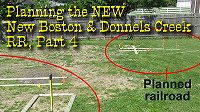 Return to "Planning the NEW New Boston and Donnels Creek, Part 4" -
Well, the rented post-hole digger fell through, so we dug our vegetable garden with a manual post-hole digger (the scissors kind). In addition, I stake out where the railroad was going to be. Twice. And tweaked the plans again. Sorry about the redo's, but sometimes just walking around the yard trying to visualize things makes me reconsider something that seemed "settled" only a few days before.
Return to "Planning the NEW New Boston and Donnels Creek, Part 4" -
Well, the rented post-hole digger fell through, so we dug our vegetable garden with a manual post-hole digger (the scissors kind). In addition, I stake out where the railroad was going to be. Twice. And tweaked the plans again. Sorry about the redo's, but sometimes just walking around the yard trying to visualize things makes me reconsider something that seemed "settled" only a few days before.
Click on the photo to see what we were considering as of late May, 2017
 Return to "Planning the NEW New Boston and Donnels Creek, Part 3" -
We have still not broken ground. In part because we plan to rent a post-hole digger and dig the post holes for our raised vegetable garden and the first phase of the garden railroad at the same time, and we don't have enough lumber on hand yet. (If we didn't break it down into multiple trips, we'd be blowing out the shocks on our minivan.) In the meantime, we used a line level to see if the slope of the back yard was as bad as we thought it was (it's worse), and we did other site preparation, including planting a whole bunch of spruce tree seedlings to eventually give us some privacy in our side and back yard. Plus, I'm still wavering a little on the "where-to-start-first" issue.
Return to "Planning the NEW New Boston and Donnels Creek, Part 3" -
We have still not broken ground. In part because we plan to rent a post-hole digger and dig the post holes for our raised vegetable garden and the first phase of the garden railroad at the same time, and we don't have enough lumber on hand yet. (If we didn't break it down into multiple trips, we'd be blowing out the shocks on our minivan.) In the meantime, we used a line level to see if the slope of the back yard was as bad as we thought it was (it's worse), and we did other site preparation, including planting a whole bunch of spruce tree seedlings to eventually give us some privacy in our side and back yard. Plus, I'm still wavering a little on the "where-to-start-first" issue.
Click on the photo to see what we were considering as of late April, 2017
 Return to "Planning the NEW New Boston and Donnels Creek, Part 2" -
More plans. We've moved on from the 2"x6" roadbed-on-posts to a sort of "train-table-outside" plan. Our goals include low-maintenance, high interest, and high reliability. We're also trying to get around having a thousand dollars' worth of dirt hauled into the back yard. If you want to get some idea of what our planning process looks like, reading these through in sequence may help. Or it may drive you crazy.
Return to "Planning the NEW New Boston and Donnels Creek, Part 2" -
More plans. We've moved on from the 2"x6" roadbed-on-posts to a sort of "train-table-outside" plan. Our goals include low-maintenance, high interest, and high reliability. We're also trying to get around having a thousand dollars' worth of dirt hauled into the back yard. If you want to get some idea of what our planning process looks like, reading these through in sequence may help. Or it may drive you crazy.
Click on the photo to see what we were considering in early April, 2017
 Return to "Planning the NEW New Boston and Donnels Creek, Part 1" -
If you're subscribed to our newsletter, you know that we moved just after Thanksgiving in 2016, leaving behind most of the track, a few of the bird feeders, and one Bachmann train set for the new owners. We also left behind a high-maintenance garden that we do not intend to replicate at the new place. This is the first chapter of a new chapter in our lives, which we hope will include a lot of "lessons learned." But first, some serious landscaping had to take place.
Return to "Planning the NEW New Boston and Donnels Creek, Part 1" -
If you're subscribed to our newsletter, you know that we moved just after Thanksgiving in 2016, leaving behind most of the track, a few of the bird feeders, and one Bachmann train set for the new owners. We also left behind a high-maintenance garden that we do not intend to replicate at the new place. This is the first chapter of a new chapter in our lives, which we hope will include a lot of "lessons learned." But first, some serious landscaping had to take place.
Click on the photo to see what we were considering in March, 2017
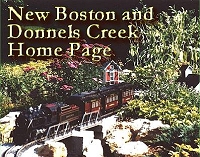 Return to the New Boston and Donnels Creek RR Page - This is the page describing Paul Race's progress and frequent rework on his own garden railroad, started on a shoe-string budget in 1998, later expanded, and later refurbished several times as issues arose. Issues that Paul hopes to avoid by building the next iteration above ground.
Return to the New Boston and Donnels Creek RR Page - This is the page describing Paul Race's progress and frequent rework on his own garden railroad, started on a shoe-string budget in 1998, later expanded, and later refurbished several times as issues arose. Issues that Paul hopes to avoid by building the next iteration above ground.
Click on the photo to see the home page of Paul's railroad.
 Return to Family Garden Trains' Home Page - The home page with links to all the other stuff, including design guidelines, construction techniques, structure tips, free graphics, and more.
Return to Family Garden Trains' Home Page - The home page with links to all the other stuff, including design guidelines, construction techniques, structure tips, free graphics, and more.
To read more, or to look at recommended Garden Railroading and Big Indoor Train products, please click on the index pages below.
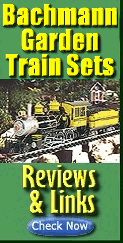


Note: Family Garden TrainsTM, Garden Train StoreTM, Big Christmas TrainsTM, BIG Indoor TrainsTM, and BIG Train StoreTM are trademarks of
Breakthrough Communications (btcomm.com). All information, data, text, and illustrations on this web site are
Copyright (c) 1999, 2000, 2001, 2002, 2003, 2004, 2005, 2006, 2007, 2008, 2009, 2010, 2011, 2012, 2013, 2014, 2015, 2016, 2017, 2018, 2019 by
Paul D. Race. Reuse or republication without prior written permission is specifically
forbidden.
Family Garden Trains is a participant in the Amazon Services LLC Associates Program,
an affiliate advertising program designed to provide a means for sites to earn advertising
fees by advertising and linking to amazon.com.
For more information, please contact us
 |  |
| Visit related pages and affiliated sites: | |||||
| - Trains and Hobbies - | |||||
 |  |
 |
 |
 |  |
 |

|

|  |
 |

|
| - Christmas Memories and Collectibles - | |||||
 |

|
 |

|
 |

|
| - Family Activities and Crafts - | |||||
 |

|

|

|

|

|
| - Music - | |||||

|
 |
 |

|

|

|

|

|

|

|

|

|

|

|

|

|

|

|

